engine Alfa Romeo Giulietta 2012 Owner handbook (in English)
[x] Cancel search | Manufacturer: ALFA ROMEO, Model Year: 2012, Model line: Giulietta, Model: Alfa Romeo Giulietta 2012Pages: 297, PDF Size: 9.37 MB
Page 211 of 297
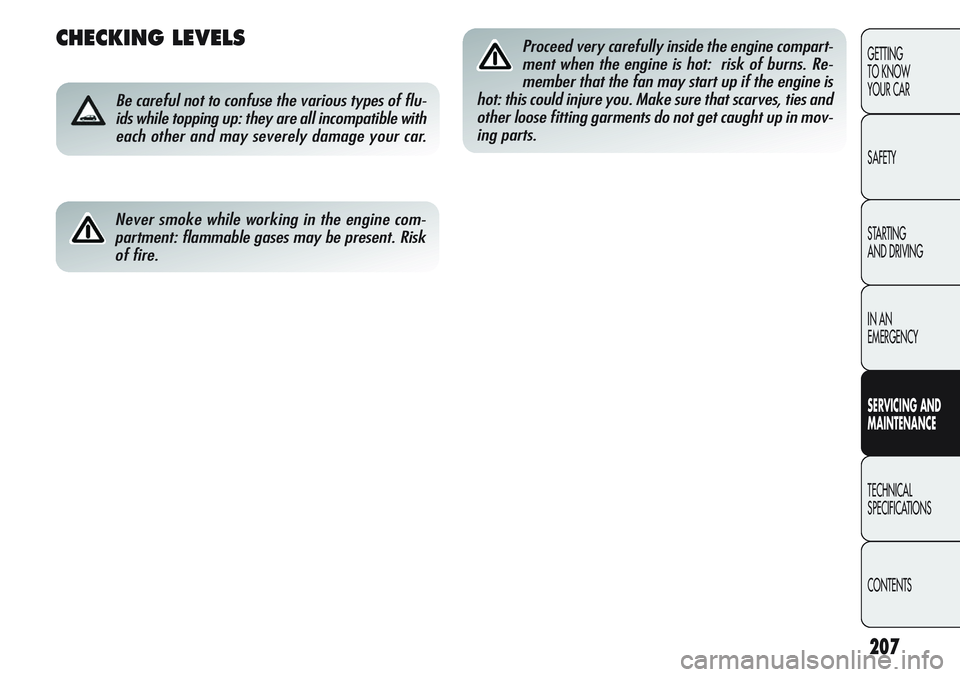
207
GETTING
TO KNOW
YOUR CAR
SAFETY
STARTING
AND DRIVING
IN AN
EMERGENCY
SERVICING AND
MAINTENANCE
TECHNICAL
SPECIFICATIONS
CONTENTS
CHECKING LEVELS
Be careful not to confuse the various types of flu-
ids while topping up: they are all incompatible with
each other and may severely damage your car.
Never smoke while working in the engine com-
partment: flammable gases may be present. Risk
of fire.
Proceed very carefully inside the engine compart-
ment when the engine is hot: risk of burns. Re-
member that the fan may start up if the engine is
hot: this could injure you. Make sure that scarves, ties and
other loose fitting garments do not get caught up in mov-
ing parts.
Page 216 of 297
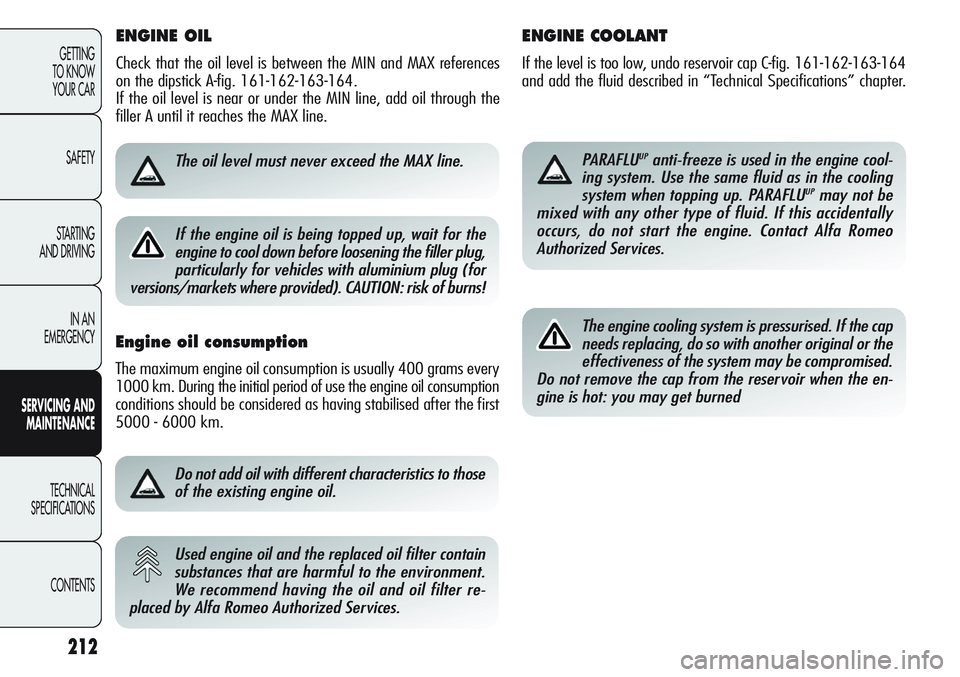
ENGINE OIL
Check that the oil level is between the MIN and MAX references
on the dipstick A-fig. 161-162-163-164.
If the oil level is near or under the MIN line, add oil through the
filler A until it reaches the MAX line.
Do not add oil with different characteristics to those
of the existing engine oil.
Used engine oil and the replaced oil filter contain
substances that are harmful to the environment.
We recommend having the oil and oil filter re-
placed by Alfa Romeo Authorized Services.
ENGINE COOLANT
If the level is too low, undo reservoir cap C-fig. 161-162-163-164
and add the fluid described in “Technical Specifications” chapter.
PARAFLUUPanti-freeze is used in the engine cool-
ing system. Use the same fluid as in the cooling
system when topping up. PARAFLU
UPmay not be
mixed with any other type of fluid. If this accidentally
occurs, do not start the engine. Contact Alfa Romeo
Authorized Services.
The engine cooling system is pressurised. If the cap
needs replacing, do so with another original or the
effectiveness of the system may be compromised.
Do not remove the cap from the reservoir when the en-
gine is hot: you may get burned
212
GETTING
TO KNOW
YOUR CAR
SAFETY
STARTING
AND DRIVING
IN AN
EMERGENCY
SERVICING AND
MAINTENANCE
TECHNICAL
SPECIFICATIONS
CONTENTS
The oil level must never exceed the MAX line.
Engine oil consumption
The maximum engine oil consumption is usually 400 grams every
1000 km. During the initial period of use the engine oil consumption
conditions should be considered as having stabilised after the first
5000 - 6000 km.
If the engine oil is being topped up, wait for the
engine to cool down before loosening the filler plug,
particularly for vehicles with aluminium plug (for
versions/markets where provided). CAUTION: risk of burns!
Page 217 of 297

213
GETTING
TO KNOW
YOUR CAR
SAFETY
STARTING
AND DRIVING
IN AN
EMERGENCY
SERVICING AND
MAINTENANCE
TECHNICAL
SPECIFICATIONS
CONTENTS
BRAKE FLUID
Check that the fluid is at the maximum level. If the level is too
low undo reservoir cap F-fig. 161-162-163-164 and add the flu-
id described in the “Technical Specifications” chapter.
Prevent brake fluid, which is highly corrosive, from
coming into contact with painted parts. Should this
occur, immediately wash with water.
WINDSCREEN/REAR WINDOW/
HEADLIGHT WASHING FLUID
If the level is too low undo reservoir cap D-fig. 161-162-163-
164 and add the fluid described in the “Technical Specifications”
chapter.
IMPORTANT The headlight washer system will not work when
the liquid level is low although the windscreen/rear window wash-
er will still work. For versions/markets where provided (see pre-
vious pages), a reference line E-fig. 161, 162, 163, 164 is pro-
vided: ONLY the windscreen/rear window washer will work un-
der this line.
Some commercial windscreen washer additives are
flammable. The engine compartment contains hot
parts which could cause a fire if they come into con-
tact with these additives.
Brake fluid is poisonous and highly corrosive. In
the event of accidental contact, wash the parts im-
mediately with water and neutral soap, then rinse
with plenty of water. In case of swallowing, immediately
call a doctor.
The symbol πon the container indicates a syn-
thetic brake fluid, which is different from a min-
eral fluid. Using a mineral-type fluid will damage
the special rubber seals of the braking system beyond re-
pair.
Do not travel if the windscreen washer reservoir is
empty: using the windscreen washer is essential
for improving visibility. Repeated operation of the
system when it is empty could damage or rapidly deteri-
orate some of its parts
Page 218 of 297
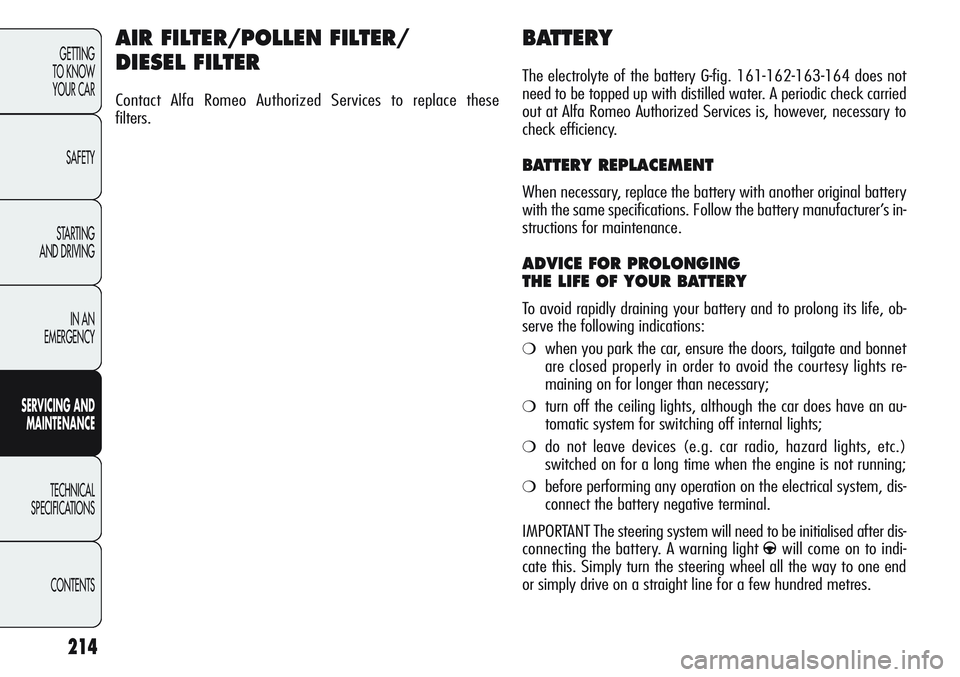
214
GETTING
TO KNOW
YOUR CAR
SAFETY
STARTING
AND DRIVING
IN AN
EMERGENCY
SERVICING AND
MAINTENANCE
TECHNICAL
SPECIFICATIONS
CONTENTS
BATTERY
The electrolyte of the battery G-fig. 161-162-163-164 does not
need to be topped up with distilled water. A periodic check carried
out at Alfa Romeo Authorized Services is, however, necessary to
check efficiency.
BATTERY REPLACEMENT
When necessary, replace the battery with another original battery
with the same specifications. Follow the battery manufacturer’s in-
structions for maintenance.
ADVICE FOR PROLONGING
THE LIFE OF YOUR BATTERY
To avoid rapidly draining your battery and to prolong its life, ob-
serve the following indications:
❍when you park the car, ensure the doors, tailgate and bonnet
are closed properly in order to avoid the courtesy lights re-
maining on for longer than necessary;
❍turn off the ceiling lights, although the car does have an au-
tomatic system for switching off internal lights;
❍do not leave devices (e.g. car radio, hazard lights, etc.)
switched on for a long time when the engine is not running;
❍before performing any operation on the electrical system, dis-
connect the battery negative terminal.
IMPORTANT The steering system will need to be initialised after dis-
connecting the battery. A warning light
gwill come on to indi-
cate this. Simply turn the steering wheel all the way to one end
or simply drive on a straight line for a few hundred metres.
AIR FILTER/POLLEN FILTER/
DIESEL FILTER
Contact Alfa Romeo Authorized Services to replace these
filters.
Page 226 of 297
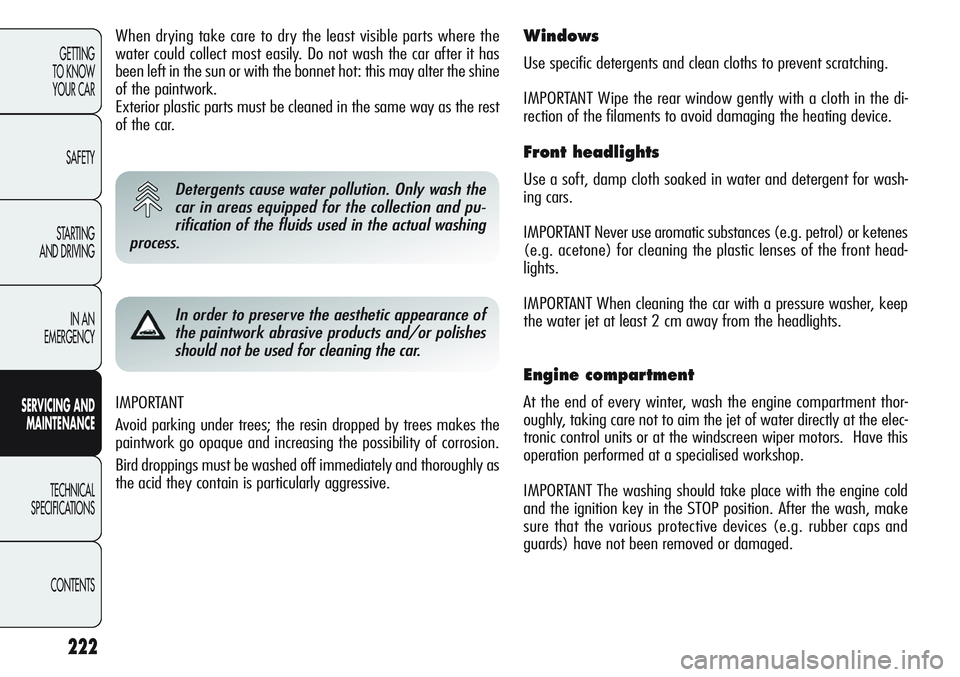
222
GETTING
TO KNOW
YOUR CAR
SAFETY
STARTING
AND DRIVING
IN AN
EMERGENCY
SERVICING AND
MAINTENANCE
TECHNICAL
SPECIFICATIONS
CONTENTS
IMPORTANT
Avoid parking under trees; the resin dropped by trees makes the
paintwork go opaque and increasing the possibility of corrosion.
Bird droppings must be washed off immediately and thoroughly as
the acid they contain is particularly aggressive.
Windows
Use specific detergents and clean cloths to prevent scratching.
IMPORTANT Wipe the rear window gently with a cloth in the di-
rection of the filaments to avoid damaging the heating device.
Front headlights
Use a soft, damp cloth soaked in water and detergent for wash-
ing cars.
IMPORTANT Never use aromatic substances (e.g. petrol) or ketenes
(e.g. acetone) for cleaning the plastic lenses of the front head-
lights.
IMPORTANT When cleaning the car with a pressure washer, keep
the water jet at least 2 cm away from the headlights.
Engine compartment
At the end of every winter, wash the engine compartment thor-
oughly, taking care not to aim the jet of water directly at the elec-
tronic control units or at the windscreen wiper motors. Have this
operation performed at a specialised workshop.
IMPORTANT The washing should take place with the engine cold
and the ignition key in the STOP position. After the wash, make
sure that the various protective devices (e.g. rubber caps and
guards) have not been removed or damaged.
Detergents cause water pollution. Only wash the
car in areas equipped for the collection and pu-
rification of the fluids used in the actual washing
process.
When drying take care to dry the least visible parts where the
water could collect most easily. Do not wash the car after it has
been left in the sun or with the bonnet hot: this may alter the shine
of the paintwork.
Exterior plastic parts must be cleaned in the same way as the rest
of the car.
In order to preserve the aesthetic appearance of
the paintwork abrasive products and/or polishes
should not be used for cleaning the car.
Page 229 of 297

225
GETTING
TO KNOW
YOUR CAR
SAFETY
STARTING
AND DRIVING
IN AN
EMERGENCY
SERVICING AND
MAINTENANCE
TECHNICAL
SPECIFICATIONS
CONTENTS
TECHNICAL SPECIFICATIONS
VIN PLATE fig. 171
It is applied to the front crossmember and shows the following
data:
B Type-approval number
C Vehicle type identification code
D Chassis number
E Maximum authorised weight of vehicle fully laden
F Maximum permitted weight of vehicle fully laden plus trailer
G Maximum permitted weight on first (front) axle
H Maximum permitted weight on second (rear) axle
I Engine type.
L Bodywork version code.
M Number for spare parts.
N Correct smoke opacity index (for diesel engines).
fig. 171A0K0024m
IDENTIFICATION DATA
The identification details of the car are:
❍VIN plate
❍Chassis marking;
❍Bodywork paint identification plate.
❍Engine marking
Page 230 of 297
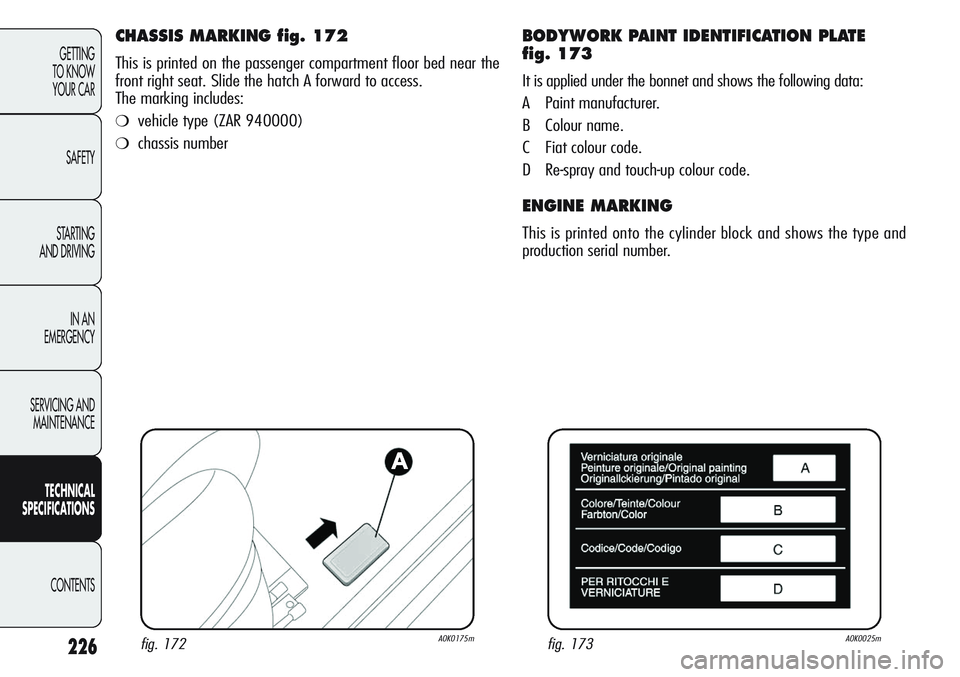
226
GETTING
TO KNOW
YOUR CAR
SAFETY
STARTING
AND DRIVING
IN AN
EMERGENCY
SERVICING AND
MAINTENANCE
TECHNICAL
SPECIFICATIONS
CONTENTS
CHASSIS MARKING fig. 172
This is printed on the passenger compartment floor bed near the
front right seat. Slide the hatch A forward to access.
The marking includes:
❍vehicle type (ZAR 940000)
❍chassis number
BODYWORK PAINT IDENTIFICATION PLATE
fig. 173
It is applied under the bonnet and shows the following data:
A Paint manufacturer.
B Colour name.
C Fiat colour code.
D Re-spray and touch-up colour code.
ENGINE MARKING
This is printed onto the cylinder block and shows the type and
production serial number.
fig. 172A0K0175mfig. 173A0K0025m
Page 231 of 297

940FXA1A 00
940FXA1A 00B (**)
940FXF1A05
940FXF1A 05B (**)
940FXB1A01
940FXB1A 01B (**)
940FXG1A06
940FXG1A 06B (**)
940FXC1A02
940FXD1A03
940FXD1A 03B (**)
940FXE1A04
940FXE1A 04B (**)
940FXM1A 09
940FXL1M 09B (**)
940FXL1A 08
940FXL1A 08B (**)
940FXH1A07
940FXH1A 07B (**)
198A4000
940A6000
940A2000
955A8000
940A1000
940A3000
940A4000
940A8000
940A5000
940A7000
227
GETTING
TO KNOW
YOUR CAR
SAFETY
STARTING
AND DRIVING
IN AN
EMERGENCY
SERVICING AND
MAINTENANCE
TECHNICAL
SPECIFICATIONS
CONTENTS
ENGINE CODES - BODYWORK VERSIONS
Engine code Bodywork versions
1.4 Turbo Petrol
1.4 Turbo Petrol (*)
1.4 Turbo Multi Air
1.4 Turbo Multi Air (*)
1750 Turbo Petrol
1.6 JTDM
2.0 JTDM
2.0 JTDM136 HP (*)
2.0 JTDM140 HP (*)
2.0 JTDM163 HP (*)
(*) For versions/markets, where provided
(**) Versions with oversized brake calipers
Page 232 of 297

940A1000
Otto
4 in line
83.0 x 80.5
1742
9.8
172.5
235
5500
NORMAL DYNAMIC
300 340
30.5 34.6
4500 1900
NGK ILKAR7D6G
Unleaded petrol
95 RON
or 98 RON
(EN228 specifications)
940A2000
955A8000 (*)
Otto
4 in line
72.0 x 84.0
1368
9,8
125 120 (*)
170 163 (*)
5500 5500 (*)
NORMAL DYNAMIC
230 250
23.4 25.4
2250 2500
NGK IKR9F8
Unleaded petrol
95 RON
or 98 RON
(EN228 specifications)
198A4000
940A6000 (*)
Otto
4 in line
72.0 x 84.0
1368
9.8
88 85 (*)
120 115 (*)
5000 5000 (*)
206
21
1750
NGK IKR9F8
Unleaded petrol
95 RON
(EN228
specifications)
228
GETTING
TO KNOW
YOUR CAR
SAFETY
STARTING
AND DRIVING
IN AN
EMERGENCY
SERVICING AND
MAINTENANCE
TECHNICAL
SPECIFICATIONS
CONTENTS
ENGINE
(*) For versions/markets, where provided
GENERAL INFORMATION 1.4 1.4 Turbo1750
Turbo Petrol Multi Air Turbo Petrol
Type code
Cycle
Cylinder number and position
Piston bore and stroke mm
Total capacity cm3
Compression ratio
Max. EEC power kW
HP
corresponding speed rpm
Max. EEC torque Nm
kgm
corresponding speed rpm
Spark plugs
Fuel
Page 244 of 297
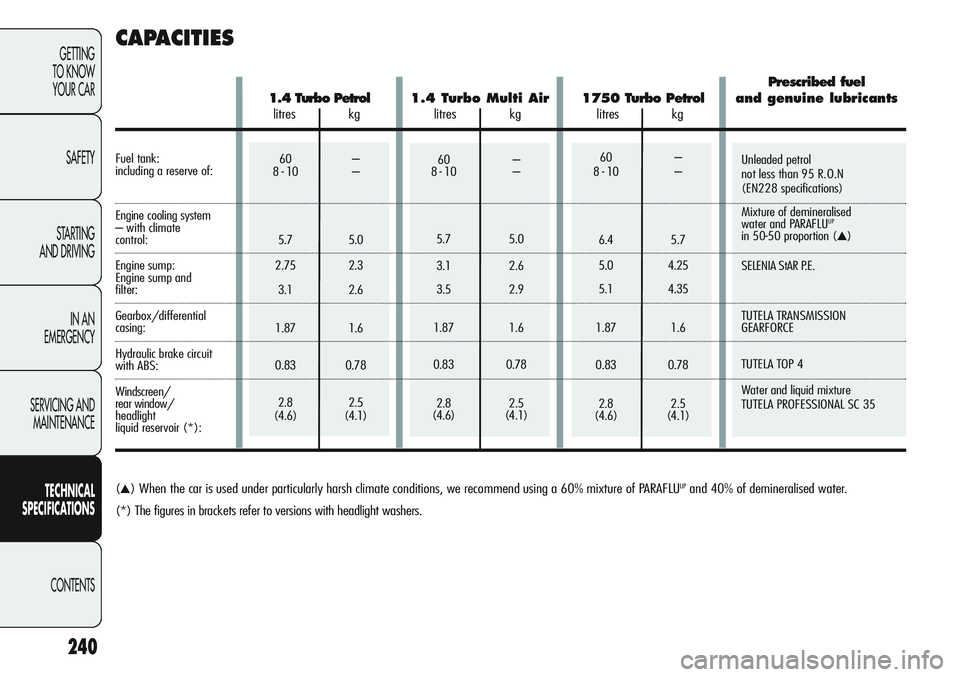
60 –
8 - 10 –
6.4 5.7
5.0 4.25
5.1 4.35
1.87 1.6
0.83 0.78
2.8 2.5
(4.6) (4.1)60 –
8 - 10 –
5.7 5.0
2.75 2.3
3.1 2.6
1.87 1.6
0.83 0.78
2.8 2.5
(4.6) (4.1)60 –
8 - 10 –
5.7 5.0
3.1 2.6
3.5 2.9
1.87 1.6
0.83 0.78
2.8 2.5
(4.6) (4.1)Unleaded petrol
not less than 95 R.O.N
(EN228 specifications)
Mixture of demineralised
water and PARAFLU
UP
in 50-50 proportion (▲)
SELENIA StAR P.E.
TUTELA TRANSMISSION
GEARFORCE
TUTELA TOP 4
Water and liquid mixture
TUTELA PROFESSIONAL SC 35
240
GETTING
TO KNOW
YOUR CAR
SAFETY
STARTING
AND DRIVING
IN AN
EMERGENCY
SERVICING AND
MAINTENANCE
TECHNICAL
SPECIFICATIONS
CONTENTS
CAPACITIES
(▲) When the car is used under particularly harsh climate conditions, we recommend using a 60% mixture of PARAFLUUPand 40% of demineralised water.
(*) The figures in brackets refer to versions with headlight washers.
Prescribed fuel
1.4 Turbo Petrol1.4 Turbo Multi Air1750 Turbo Petrol and genuine lubricants
litres kg litres kg litres kg
Fuel tank:
including a reserve of:
Engine cooling system
– with climate
control:
Engine sump:
Engine sump and
filter:
Gearbox/differential
casing:
Hydraulic brake circuit
with ABS:
Windscreen/
rear window/
headlight
liquid reservoir (*):